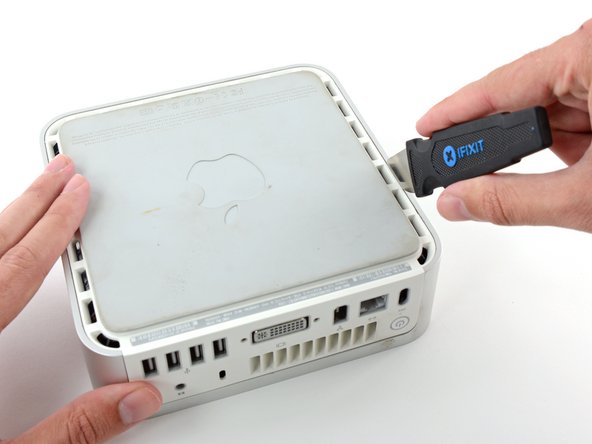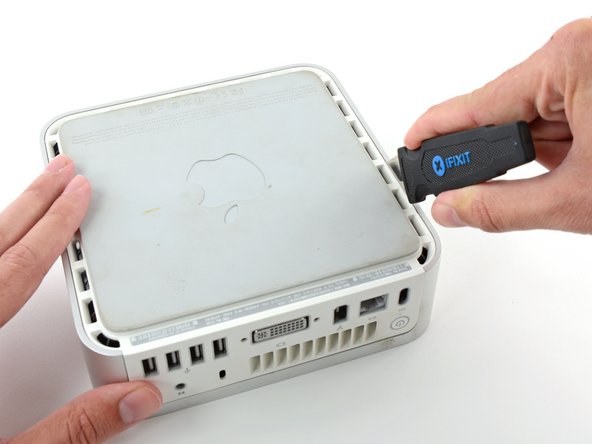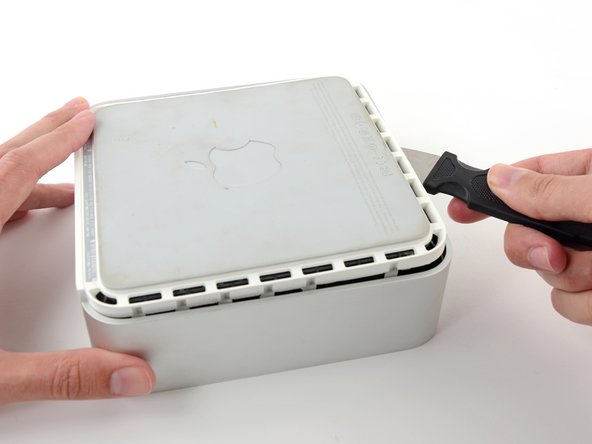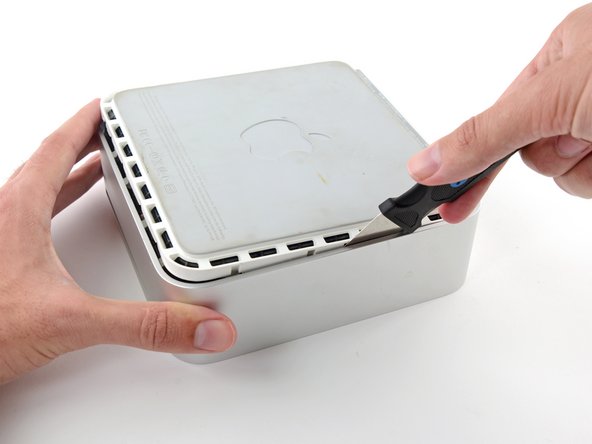Einleitung
Diese Anleitung zeigt, wie die Festplatte ausgetauscht oder aufgerüstet werden kann.
Was du brauchst
-
-
Schalte deinen Mac Mini aus, trenne alle Kabel und drehe ihn um.
-
Führe den Jimmy in den Spalt zwischen dem oberen Aluminiumgehäuse und dem unteren Kunststoffgehäuse ein.
-
Der Jimmy sollte nach ungefähr 9,5 mm stoppen.
-
-
-
Biege den Jimmy vorsichtig nach außen, um den Spalt ein wenig weiterzu öffnen, und hebe das untere Gehäuse ein wenig an.
Patience is your best friend.
Do not insert “jimmy in too far. Marking a line from tip upwards on the tool will prevent too far insertion, possibly breaking tabs or damaging internal components.
To prevent the cover closing back up, small strips of matchbook cover (os equivalent) can be inserted about half inch hold prevent closure.
-
-
-
Wenn du die erste Seite gelöst hast, drehe den Mac Mini und beginne, an der Vorderkante zu hebeln.
-
Biege mit der gleichen Hebelbewegung die Clips nach innen und hebe das untere Gehäuse aus dem oberen Gehäuse heraus.
-
-
-
Möglicherweise musst du den Jimmy an der Kante entlang bewegen, um alle Clips zu lPosen. Sei geduldig und arbeite dich schrittweise vor.
-
-
-
Drehe den Mac Mini wieder auf die Vorderseite und hebe das obere Gehäuse vom unterem Gehäuse ab.
-
-
-
-
Greife die AirPort-Antennenplatine und hebe sie von den beiden Kunststoffstiften ab, mit denen sie befestigt ist. Möglicherweise musst du die schwarze Kunststofflasche, die durch die untere linke Ecke der Platine ragt, zurückschieben.
-
-
-
Entferne das gelbe Klebeband, mit dem das Netzschalterkabel am schwarzen Kunststoffrahmen befestigt ist.
-
-
-
Entferne die drei schwarzen Kreuzschlitzschrauben, mit denen der Kunststoffrahmen am Logic Board und am unteren Gehäuse befestigt ist.
-
-
-
Fasse das optische Laufwerk und die Festplatte mit einer Hand und hebe sie so weit an, dass du darunterschauen kannst.
I just put in a 1G RAM chip that just came in the mail from iFixit. And though I followed every step this step (removing the HD, cooling fan, and drive unit) was not needed. I put the chip in, put everything back in place then removed and replaced the RAM with no problems. So it would seem that for a/my PowerPC Mac Mini (I have a 1.33 Ghz processor) it was not a needed step.
BTW, it took about 15 - 20 min even with my experimentation.
Zitat von mbob518:
I just put in a 1G RAM chip that just came in the mail from iFixit. And though I followed every step this step (removing the HD, cooling fan, and drive unit) was not needed. I put the chip in, put everything back in place then removed and replaced the RAM with no problems. So it would seem that for a/my PowerPC Mac Mini (I have a 1.33 Ghz processor) it was not a needed step.
-
-
-
Andernfalls musst du zuerst das AirPort- und/oder Bluetooth-Antennenkabel abtrennen.
-
Ziehe mit der freien Hand das Bluetooth-Kabel von der Bluetooth-Platine nach oben und ziehe das Airport-Antennenkabel rechts von der Airport-Karte ab. Achtung: diese beiden Anschlüsse sind sehr klein.
-
Beim Zusammenbau musst du erst die beiden Schrauben entfernen, mit denen die AirPort-Karte an der Baugruppe befestigt ist, und die Karte anheben und herausnehmen, um die Kabel wieder anzuschließen.
Same problem here on this one. There seems to be no way to get them off and I can't seem to unscrew this thing. I think this otherwise great guide should be more precise about how to get the antenna cables out of the way :-(
Antenna cables just pop off - straight up.
Must be perfectly aligned when reconnecting as well before you re-seat them.
Small needle nose pliers may be useful or a spudger or flat jewelers screwdriver to pry up on the cable as close to the connector as possible.
-
-
-
Drehe die drei langen, schwarzen Kreuzschlitzschrauben in den Ecken des Lüfters heraus. Diese Schrauben sitzen sehr fest, du wirst ziemlich viel Kraft benötigen.
-
-
-
Ziehe das gelbe Klebeband ab, mit dem die Kabel vom Lüfter und vom Lautsprecher auf der Unterseite der Festplatte befestigt sind.
-
-
-
Entferne die beiden Kreuzschlitzschrauben #1, mit denen die rechte Seite des Laufwerks am Kunststoffrahmen befestigt ist. Um an die untere rechte Schraube zu gelangen, musst du den Schraubendreher etwas schräg nach unten halten. Drücke fest und gleichmäßig auf die Schrauben, drehe sie langsam heraus, damit ihre Köpfe nicht rundgedreht werden.
If one has a thin screwdriver, there is a hole in the plastic to keep the screwdriver straight when removing the lower right screw. That hole is closed with a piece of yellow tape to keep the airflow, so after replacing the drive, one needs to use a piece of scotch tape to cover the hole again.
-
-
-
Entferne mit dem gleichen Schraubendreher die beiden Schrauben, mit denen die linke Seite der Festplatte am Kunststoffrahmen befestigt ist, drehe auch hier fest und gleichmäßig.
-
-
-
Heble die Festplatte mit dem Spudger von der Interface-Platine weg. Klemme die Klinge des Spudgers zwischen die Anschlussplatine und der ganz rechts liegenden Seite der Festplatte hinein. Wackle dann etwas vor und zurück, bis sie etwa 2 mm herausgekommen ist. Wiederhole dann das Ganze an der anderen Seite. Gehe hin und her, bis sie draußen ist.
-
Um dein Gerät wieder zusammenzubauen, folge den Schritten in umgekehrter Reihenfolge.
Um dein Gerät wieder zusammenzubauen, folge den Schritten in umgekehrter Reihenfolge.
Rückgängig: Ich habe diese Anleitung nicht absolviert.
106 weitere Nutzer:innen haben diese Anleitung absolviert.
Besonderer Dank geht an diese Übersetzer:innen:
100%
Diese Übersetzer:innen helfen uns, die Welt zu reparieren! Wie kann ich mithelfen?
Hier starten ›
Angehängte Dokumente
10 Kommentare
Pulled the 40GB drive from my Mac Mini G4 and replaced it with a solid state drive (mSATA to PATA enclosure with a 120GB mSATA drive). Since my Mac Mini runs MorphOS instead of OS X, it’s been absolutely screaming; MorphOS booted in 10 seconds on the HDD, and now it’s “blink and you’ll miss it” fast on the SSD! :)
I dropped the three screws on the floor and can’t find them. What size are these screws so I can buy new ones?
I made those changes with an PATA to SATA adapter but my SSD isn’t recognized, do you have a solution or a specific accessory?
Another problem I have is in C704 capacitor (closely to the processor backward from DVI port) that is broken...Do you know what are the main characteristics of it to change it? Thanks…
@fordeverblue Check the jumper settings on the drive. The optical drive and the hard drive share the same channel, so one has to be set to primary and the other to secondary (“master” and “slave”). “Cable Select” won’t work AFAIK. A lot of Apple combo drives have no jumpers and are always primary, so the HDD has to be secondary. Some PATA to IDE adapters have no jumpers or have jumpers without documentation, so some trial and error may be in order.
Hi, thanks for your advice. I was thinking that the HDD was the primary but if you say that the Combo Drive is I will try to put the Jumper as Secondary.
Which PATA to SATA adapter did you guys use successfully for an SSD replacement? (specific links please) I mistakenly bought a 40-Pin IDE to SATA Converter (the StarTech one), which worked great for replacing HDs to SSDs in two G3 iMacs, but obviously this won’t fit this config. Not only is the pinout wrong (NOW I know the difference between IDE and PATA) but the adapter won’t even fit into the drive enclosure. Thanks all. Looking to complete my plan to supercharge this 1.25 Ghz Mac Mini with the SSD as well as 1 gig of RAM.
I always make my own IDE drives from an 1.8" mSATA SSD and a mSATA/IDE case. Has always worked great in everything from the G3 Pismo on up.
The steps I used to install Leopard on my new hard drive (PATA) are shown here: https://archive.org/details/osx-leopard-...
or here:
I started with a new hard drive and formatted it using a Vantec IDE/SATA to USB 3.0 adapter (best $20 I've spent) on a mac running High Sierra. Using disk utility, I clicked on the new drive, then "View" and then "Show all devices". I clicked on "Erase", and the option for "Apple Partition Map" appears, and Mac OS Extended (Journaled), and ran that to format the drive. Then put the drive in the computer.
I downloaded the ISO file onto my computer. Formatted the flash drive to Mac OS Extended (Journaled), and clicked on "Restore", using the iso file for the "restore from" option, and the flash drive as the destination. This is the boot drive.I put the flash drive was in the computer and booted it into Open Firmware by clicking option-command-O-F after the chime. The drive happened to be inserted in "USB1", so I typed Boot usb1/disk@1:,\\:tbxi
If "usb1" doesn't work, try "usb0"
The hard drive may require partitioning....the first time I formatted it as Mac OS Extended (Journaled) I created a Guid partition. I don't know whether the partition is required for the drive to function, but it didn't hurt anything, once I had the correct formatting (above).
wyrra -



























A spackle knife makes these steps go much faster.
jouniseppanen - Antwort
A double sided letter opener or a thin non-serrated butter knife will suffice.
To prenent cosmetic blemishes, place a matchbook cover or similar thin cardboard on the outer perimeter under the “jimmy”.
Mike - Antwort